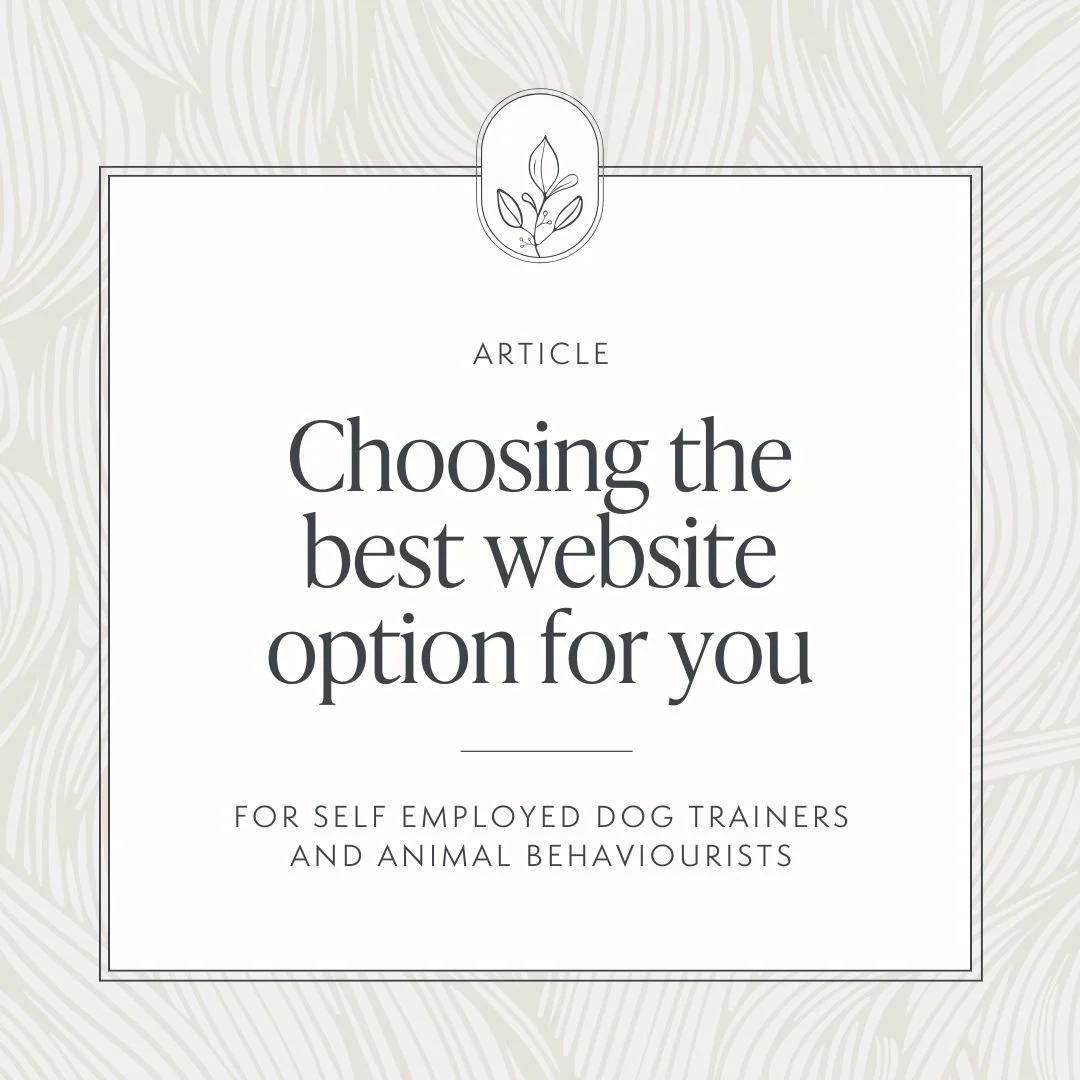Six simple tweaks to help your dog training/ animal behaviour website work harder for you
It’s often said that your website should be your hardest working employee. Even if you don’t have any employees then I’m sure you get the gist!
A great website can make a huge difference to your business. It can help you to be found online, impress your potential clients and, ultimately, encourage them to choose to work with you. But, let’s be honest, it’s not easy to have a great website…. if it was, everyone would have one!
Of course, a total overhaul is necessary in some cases and hiring a professional to create a website which is perfectly tailored to your needs will undoubtedly be your best bet (see how I can help with this!). But if you’re not ready for that just now, there are still some simple tweaks that you can make to your DIY site, to help it do its job that bit better.
#01 - Use keywords wisely
SEO (Search Engine Optimisation) is a BIG topic - far bigger than I can cover properly here! - but, in essence, it’s all about helping you to come up in online searches. Keywords are an important part of this. Keywords are basically the phrases that people might search for if they’re looking for what you offer. For example, it might be ‘online dog trainer’, ‘reactive dog help in Hampshire’ or ‘puppy classes in Cardiff’.
Ideally, you would have considered your keywords when planning your website strategy (i.e. before you even started creating your website!). However, if you didn’t (or you think it might have got a bit lost in translation), you can still make changes now.
Think about what keywords you would like to some up for in online searches and make sure that these words/ phrases are included in:
your headings (your H1 for each page, in particular)
your paragraph text (don’t ‘cram’ keywords in though - it needs to feel natural)
your SEO settings in your website ‘back-end’ - this depends on your website builder
Bonus tip - If you have different pages for each of your services, make sure that your keywords/ phrases relate to the specific service on that page.
Want step by step guidance to get your business found online and have your website coming up higher in search results?
Check out my e-book ‘The Dog Trainer’s Guide to Getting Found Online’.
#02 - Write how you talk
Many people adopt a strangely formal tone of voice when they’re writing their website copy, thinking that this helps them to come across as professional. However, one of your website’s most important jobs is to help you build a connection with your ideal clients and this is going to be difficult if you’re not being yourself!
Potential clients want to get a feel for who you are and what it would be like to work with you: writing in the way that you talk is one of the best ways that you can do this.
Of course, you still need to check your spelling and grammar and maintain a certain level of professionalism but don’t be afraid to show some personality in the way that you write your website copy.
Bonus tip - Use your ideal clients’ own language where possible. For example, if you know that your clients tend to say that they’re frustrated by their dog’s behaviour, you can use that same language in your website copy, to help them see that you understand.
Want to get your website copy in tip top shape, to take prospective clients from ‘cold’ to ‘sold’?
Check out my online course (with industry-specific guidance, templates, prompts and checklists): How To Write Your Website.
#03 - Give them a break
We often have so much information to share that it’s easy to overwhelm a potential client with a big wall of text. Sure, you might have spent hours making sure that it’s a beautifully crafted, engaging and persuasive piece of writing but if nobody reads it, then it’s all a waste of time.
It might surprise you to learn that the average amount of time a website visitor spends on a page is somewhere between 45 - 55 seconds. People simply don’t read all of the words on every page of your site - they skim read… and are very likely to click on that pesky cross in the corner and go elsewhere if they’re hit with something that makes it hard for them to pick out the key information they’re looking for.
To avoid this, you should:
be concise and choosy about what to include - what do they need to know right now?
use bullet points and subheadings to break up your text and provide helpful structure
include well-chosen images for visual appeal and to help communicate your message
Bonus tip - Don’t be afraid of ‘white space’ (areas of the page with nothing in it!). It’s tempting to cram in lots of text and images but it’s better to let everything breathe!
#04 - Tell people what to do
For each page of your website, think about what you’d like your ideal client to actually *do*. Perhaps you want them to book a call with you? Or complete a contact form? Or book a class online?
Now, I know this sounds silly but you actually need to tell potential clients who are visiting your site what action you want them to take.
This is called a Call To Action (CTA). It usually (although not always) starts with a verb eg. ‘Explore my services’ or ‘Book now’.
You should make sure that each page has a clear CTA… and, in some cases, you might repeat this same CTA (or a variation of it with the same goal) a few times on the same page. For example, you might have ‘Find out more’, ‘I want this!’ and ‘Learn more’ all at different points on the same page but each of them takes the person to the same place.
On some pages, there might be more than one action that you’d like people to take eg. one section of your homepage might encourage them to sign up for your mailing list while another section could take them to another page outlining a specific service.
Bonus tip - Having your CTAs in the format of a button in a contrasting colour (so it’s blindingly obvious that it’s something to click on) encourages more people to take action.
#05 - Share social proof
Lots of people like to have a separate testimonials/ reviews page on their website. Whilst that’s fine (although I don’t do it myself), please don’t make the mistake of not scattering testimonials throughout the rest of your site too.
Sharing social proof is so powerful that you’re missing a trick if you’re just keeping it all in one place.
I would recommend that you have at least one testimonial on every page of your website. If you have lots of lovely testimonials to choose from, select the ones that are the best fit for each page (if you don’t have many, you should read this article!). For example, a testimonial about how you helped a ‘reactive dog’ might be well placed on a ‘behaviour support’ page, whereas a review of your puppy classes would be a better choice on a page about that particular service.
As for your homepage, you can either use general reviews about what it’s like to work with you or display a selection to demonstrate the variety of issues that you’re able to support people with.
Bonus tip - Try to choose testimonials that your ideal clients will connect with. For example, if you work with a lot of poodle mixes (and love doing so) then mentioning the breed - or, even better, having a photo of the dog related to the testimonial - will help similar dog owners feel confident that you can help them too.
#06 - Choose the right images
Whilst we shouldn’t ‘judge a book by its cover’, we also know that ‘pictures can paint 1000 words’. Selecting the right images to use on your website is not easy but if you get it right then it can really help potential clients to get a good first impression of you.
When choosing images for your website, you should make sure that:
they feel ‘on brand’ - the mood they evoke and the colours that you use
they present you in a positive light - no piles of washing up in the background!
they’re good quality - in focus, well lit and not pixelated/ blurry
You can take your own photos or use stock images. Try Unsplash and Pexels for free stock photos.
Oh and even if you hate having photos taken of yourself (I feel you - I’m the same!) then make sure that you include at least one of you - on your ‘About’ page, as a minimum.
Bonus tip - Make sure that you compress your images before uploading them to your site, otherwise, this can really affect your page loading speed (which is a critical factor in how Google sees your site and whether people interact with it). You can use a free online tool such as Tiny PNG to compress images (JPEG/ PNG) to make the file size smaller without losing quality/ clarity.
You can find out more about choosing (and optimising) the right images for you in this blog post.
So there you have it! I could share website tips all day (yes, I’m a nerd!) but I’m hoping that these six tweaks will get you started, without overwhelming you :)
Need a bit of help?
Here are two great options for you to consider:
Make your life easier by purchasing one of my website templates - they’ve been designed with all of the above in mind. Beautiful, strategic and easy to use… My industry-specific website templates have it all! Find out more about my Squarespace website templates here.
Get my expert feedback, strategic input and personalised advice with a 1:1 website audit of your current site. Find out more about my website audit service here.
Please feel free to share this article…
READ MORE Posts like this ONE








